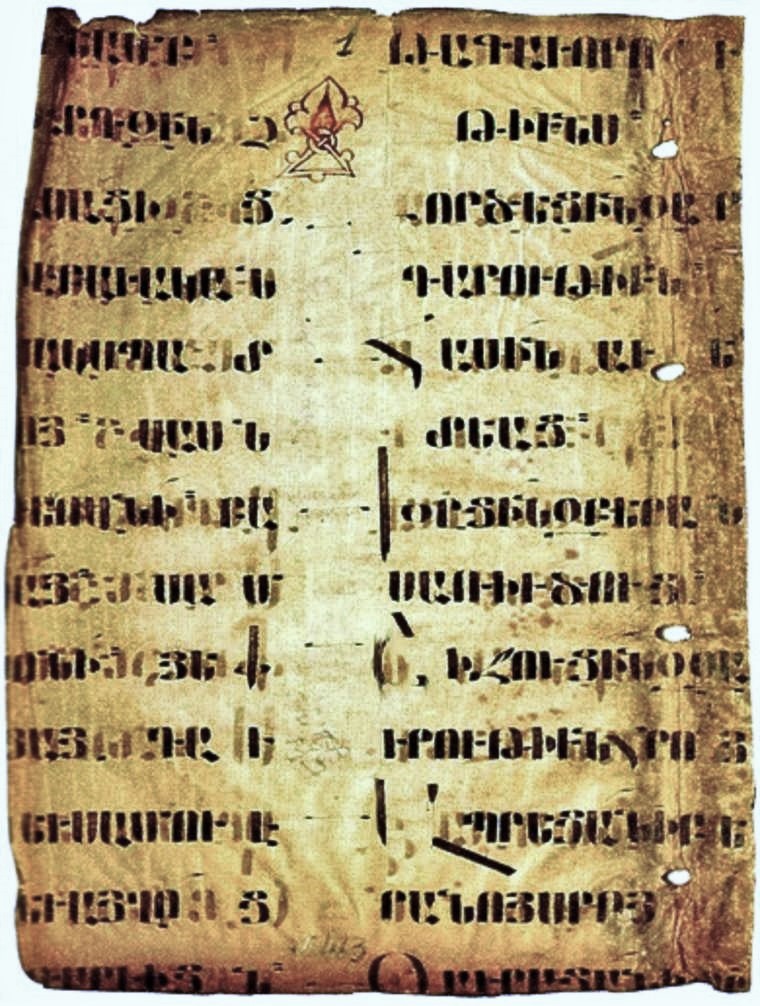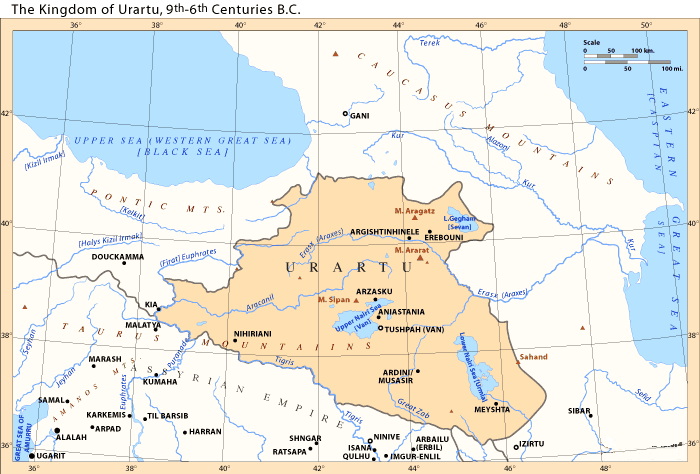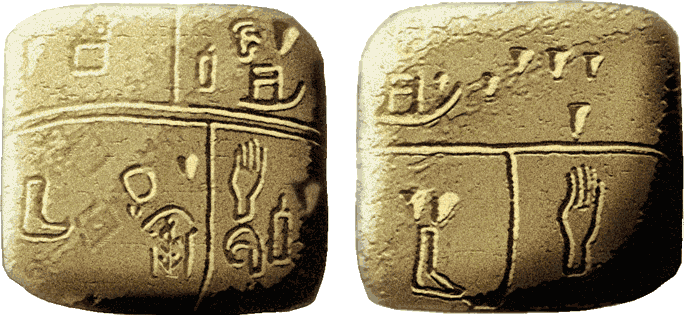|
Urartian
Urartian or Vannic is an extinct Hurro-Urartian language which was spoken by the inhabitants of the ancient kingdom of Urartu (''Biaini'' or ''Biainili'' in Urartian), which was centered on the region around Lake Van and had its capital, Tushpa, near the site of the modern town of Van in the Armenian highlands (now in the Eastern Anatolia region of Turkey). Its past prevalence is unknown. While some believe it was probably dominant around Lake Van and in the areas along the upper Zab valley, others believe it was spoken by a relatively small population who comprised a ruling class. First attested in the 9th century BCE, Urartian ceased to be written after the fall of the Urartian state in 585 BCE and presumably became extinct due to the fall of Urartu. It must have had long contact with, and been gradually totally replaced by, an early form of Armenian, although it is only in the 5th century CE that the first written examples of Armenian appear. Classification Urartian is an ... [...More Info...] [...Related Items...] OR: [Wikipedia] [Google] [Baidu] |
Urartu
Urartu (; Assyrian: ',Eberhard Schrader, ''The Cuneiform inscriptions and the Old Testament'' (1885), p. 65. Babylonian: ''Urashtu'', he, אֲרָרָט ''Ararat'') is a geographical region and Iron Age kingdom also known as the Kingdom of Van, centered around Lake Van in the historic Armenian Highlands. The kingdom rose to power in the mid-9th century BC, but went into gradual decline and was eventually conquered by the Iranian Medes in the early 6th century BC. Since its re-discovery in the 19th century, Urartu, which is commonly believed to have been at least partially Armenian-speaking, has played a significant role in Armenian nationalism. Names and etymology Various names were given to the geographic region and the polity that emerged in the region. * Urartu/Ararat: The name ''Urartu'' ( hy, Ուրարտու; Assyrian: '; Babylonian: ''Urashtu''; he, אֲרָרָט ''Ararat'') comes from Assyrian sources. Shalmaneser I (1263–1234 BC) recorded a campaign i ... [...More Info...] [...Related Items...] OR: [Wikipedia] [Google] [Baidu] |
Hurro-Urartian Languages
The Hurro-Urartian languages are an extinct language family of the Ancient Near East, comprising only two known languages: Hurrian and Urartian. Origins It is often assumed that the Hurro-Urartian languages (or a pre-split Proto-Hurro-Urartian language) were originally spoken in the Kura-Araxes culture. External classification While the genetic relation between Hurrian and Urartian is undisputed, the wider connections of Hurro-Urartian to other language families are controversial. After the decipherment of Hurrian and Urartian inscriptions and documents in the 19th and early 20th century, Hurrian and Urartian were soon recognized as not related to the Semitic nor to the Indo-European languages, and to date, the most conservative view holds that Hurro-Urartian is a primary language family not demonstrably related to any other language family. Early proposals for an external genetic relationship of Hurro-Urartian variously grouped them with the Kartvelian languages, Elamite, ... [...More Info...] [...Related Items...] OR: [Wikipedia] [Google] [Baidu] |
Hurrian Language
Hurrian is an extinct Hurro-Urartian language spoken by the Hurrians (Khurrites), a people who entered northern Mesopotamia around 2300 BC and had mostly vanished by 1000 BC. Hurrian was the language of the Mitanni kingdom in northern Mesopotamia and was likely spoken at least initially in Hurrian settlements in modern-day Syria. It is generally believed that the speakers of this language originally came from the Armenian Highlands and spread over southeast Anatolia and northern Mesopotamia at the beginning of the 2nd millennium BC. Classification Hurrian is closely related to Urartian, the language of the ancient kingdom of Urartu. Together they constitute the Hurro-Urartian language family. The external connections of the Hurro-Urartian languages are disputed. There exist various proposals for a genetic relationship to other language families (e.g. the Northeast Caucasian languages, Indo-European languages, or Kartvelian languages which are spoken in Georgia). It has ... [...More Info...] [...Related Items...] OR: [Wikipedia] [Google] [Baidu] |
Armenian Language
Armenian ( classical: , reformed: , , ) is an Indo-European language and an independent branch of that family of languages. It is the official language of Armenia. Historically spoken in the Armenian Highlands, today Armenian is widely spoken throughout the Armenian diaspora. Armenian is written in its own writing system, the Armenian alphabet, introduced in 405 AD by the priest Mesrop Mashtots. The total number of Armenian speakers worldwide is estimated between 5 and 7 million. History Classification and origins Armenian is an independent branch of the Indo-European languages. It is of interest to linguists for its distinctive phonological changes within that family. Armenian exhibits more satemization than centumization, although it is not classified as belonging to either of these subgroups. Some linguists tentatively conclude that Armenian, Greek (and Phrygian) and Indo-Iranian were dialectally close to each other;''Handbook of Formal Languages'' (1997p. ... [...More Info...] [...Related Items...] OR: [Wikipedia] [Google] [Baidu] |
Proto-Armenian Language
Proto-Armenian is the earlier, unattested stage of the Armenian language which has been reconstructed by linguists. As Armenian is the only known language of its branch of the Indo-European languages, the comparative method cannot be used to reconstruct its earlier stages. Instead, a combination of internal and external reconstruction, by reconstructions of Proto-Indo-European and other branches, has allowed linguists to piece together the earlier history of Armenian. Definition Proto-Armenian, as the ancestor of only one living language, has no clear definition of the term. It is generally held to include a variety of ancestral stages of Armenian between Proto-Indo-European and the earliest attestations of Classical Armenian. It is thus not a proto-language in the strict sense, but "Proto-Armenian" is a term that has become common in the field. The earliest testimony of Armenian is the 5th-century Bible translation of Mesrop Mashtots. The earlier history of the language is u ... [...More Info...] [...Related Items...] OR: [Wikipedia] [Google] [Baidu] |
Northeast Caucasian Languages
The Northeast Caucasian languages, also called East Caucasian, Nakh-Daghestani or ''Vainakh-Daghestani'', is a family of languages spoken in the Russian republics of Dagestan, Chechnya and Ingushetia and in Northern Azerbaijan as well as in diaspora populations in Western Europe and the Middle East. They are occasionally called ''Caspian'', as opposed to ''Pontic'' for the Northwest Caucasian languages. Name of the family Several names have been in use for this family. The most common term, ''Northeast Caucasian'', contrasts the three established families of the Caucasian languages: ''Northeast Caucasian'', ''Northwest Caucasian'' (Abkhaz–Adyghean) and ''South Caucasian'' (Kartvelian). This may be shortened to ''East Caucasian''. The term ''Nakh(o)-Dagestanian'' can be taken to reflect a primary division of the family into Nakh and Dagestanian branches, a view which is no longer widely accepted, or ''Dagestanian'' can subsume the entire family. The rare term ''North Cas ... [...More Info...] [...Related Items...] OR: [Wikipedia] [Google] [Baidu] |
Van, Turkey
Van ( hy, Վան; ku, Wan) is a mostly Kurdish-populated and historically Armenian-populated city in eastern Turkey's Van Province. The city lies on the eastern shore of Lake Van. Van has a long history as a major urban area. It has been a large city since the first millennium BCE, initially as Tushpa, the capital of the kingdom of Urartu from the 9th century BCE to the 6th century BCE, and later as the center of the Armenian kingdom of Vaspurakan. Turkic presence in Van and in the rest of Anatolia started as a result of Seljuk victory at the Battle of Malazgirt (1071) against the Byzantine Empire. Van is often referred to in the context of Western Armenia and Northern Kurdistan. History Archaeological excavations and surveys carried out in Van province indicate that the history of human settlement in this region goes back at least as far as 5000 BCE. The Tilkitepe Mound, which is on the shores of Lake Van and a few kilometres to the south of Van Castle, is the on ... [...More Info...] [...Related Items...] OR: [Wikipedia] [Google] [Baidu] |
Diauehi
Diauehi ( Georgian ''დიაოხი,'' Urartian ''Diauehi'', Greek ''Taochoi'', Armenian '' Tayk'', possibly Assyrian ''Daiaeni'',) was a tribal union located in northeastern Anatolia, that was recorded in Assyrian and Urartian sources during the Iron Age. It is usually (though not always) identified with the earlier Daiaeni (Dayaeni), attested in the Yonjalu inscription of the Assyrian king Tiglath-Pileser I's third year (1118 BC) and in later records by Shalmaneser III (845 BC). While it is unknown what language(s) they spoke,Robert. H. Hewsen. ''The Geography of Ananias of Širak: Ašxarhacʻoycʻ, the Long and the Short Recensions''. 1992. https://archive.org/stream/TheGeographyOfAnaniasOfSirak/The%20Geography%20of%20Ananias%20of%20Sirak_djvu.txt they may have been speakers of a Kartvelian,A. G. Sagona. ''Archaeology at the North-East Anatolian Frontier'', p. 30. Armenian, or Hurrian language. Location Although the exact geographic extent of Diauehi is still un ... [...More Info...] [...Related Items...] OR: [Wikipedia] [Google] [Baidu] |
Cuneiform
Cuneiform is a logo- syllabic script that was used to write several languages of the Ancient Middle East. The script was in active use from the early Bronze Age until the beginning of the Common Era. It is named for the characteristic wedge-shaped impressions ( Latin: ) which form its signs. Cuneiform was originally developed to write the Sumerian language of southern Mesopotamia (modern Iraq). Cuneiform is the earliest known writing system. Over the course of its history, cuneiform was adapted to write a number of languages in addition to Sumerian. Akkadian texts are attested from the 24th century BC onward and make up the bulk of the cuneiform record. Akkadian cuneiform was itself adapted to write the Hittite language in the early second millennium BC. The other languages with significant cuneiform corpora are Eblaite, Elamite, Hurrian, Luwian, and Urartian. The Old Persian and Ugaritic alphabets feature cuneiform-style signs; however, they are unrelated to the ... [...More Info...] [...Related Items...] OR: [Wikipedia] [Google] [Baidu] |
Assyrian Cuneiform
Cuneiform is a logo- syllabic script that was used to write several languages of the Ancient Middle East. The script was in active use from the early Bronze Age until the beginning of the Common Era. It is named for the characteristic wedge-shaped impressions ( Latin: ) which form its signs. Cuneiform was originally developed to write the Sumerian language of southern Mesopotamia (modern Iraq). Cuneiform is the earliest known writing system. Over the course of its history, cuneiform was adapted to write a number of languages in addition to Sumerian. Akkadian texts are attested from the 24th century BC onward and make up the bulk of the cuneiform record. Akkadian cuneiform was itself adapted to write the Hittite language in the early second millennium BC. The other languages with significant cuneiform corpora are Eblaite, Elamite, Hurrian, Luwian, and Urartian. The Old Persian and Ugaritic alphabets feature cuneiform-style signs; however, they are unrelated to the cun ... [...More Info...] [...Related Items...] OR: [Wikipedia] [Google] [Baidu] |
Tushpa
Tushpa ( hy, Տոսպ ''Tosp'', Akkadian: ''Turuspa'', tr, Tuşpa; from Urartianbr>tur-, ''to destroy''i.e. victorious) was the 9th-century BC capital of Urartu, later becoming known as Van which is derived from ''Biainili'', the native name of Urartu. The ancient ruins are located just west of Van and east of Lake Van in the Van Province of Turkey.http://rbedrosian.com/Classic/kvan1.htm In 2016 it was inscribed in the Tentative list of World Heritage Sites in Turkey. It was possibly pronounced as "Tospa" in ancient times as there was no symbolic ''O'' equivalent in Akkadian cuneiform so the symbol used for ''U'' was frequently substituted. History Archaeological excavations and surveys carried out in the Van Province indicate that the history of human settlement in this region dates back at least as far as 5000 BC. The Mound located along the shores of Lake Van and a few kilometres to the south of the citadel of Van, is the only known source of information about the olde ... [...More Info...] [...Related Items...] OR: [Wikipedia] [Google] [Baidu] |
Cuneiform
Cuneiform is a logo- syllabic script that was used to write several languages of the Ancient Middle East. The script was in active use from the early Bronze Age until the beginning of the Common Era. It is named for the characteristic wedge-shaped impressions ( Latin: ) which form its signs. Cuneiform was originally developed to write the Sumerian language of southern Mesopotamia (modern Iraq). Cuneiform is the earliest known writing system. Over the course of its history, cuneiform was adapted to write a number of languages in addition to Sumerian. Akkadian texts are attested from the 24th century BC onward and make up the bulk of the cuneiform record. Akkadian cuneiform was itself adapted to write the Hittite language in the early second millennium BC. The other languages with significant cuneiform corpora are Eblaite, Elamite, Hurrian, Luwian, and Urartian. The Old Persian and Ugaritic alphabets feature cuneiform-style signs; however, they are unrelated to the ... [...More Info...] [...Related Items...] OR: [Wikipedia] [Google] [Baidu] |




